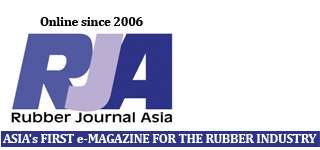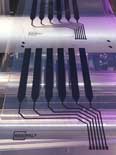German chemicals firm Wacker has commenced the serial production of sensor laminates, thereby taking the production of flexible printed electronics to the next level, it adds. At this year’s K2025 trade fair, to be held in Düsseldorf, Germany, from October 8 to 15, the company will be presenting itself as a manufacturer of prefabricated components. The laminates which are offered under the brand name Nexipal Sense are produced using a specially developed and fully automated roll-to-roll manufacturing process.
Nexipal Sense consists of highly stretchable insulating and electrically conductive silicone rubber films. The laminate, a stack of film layers, jointly works as a flexible and stretchable capacitor. Pressure or flex movements change the electrical capacitance of the component. Different capacity states thus provide precise sensor signals for applications in medical technology, robotics and sports.
By initiating the serial production of the laminates, Wacker says it has moved forward from a material supplier to a producer of prefabricated components – customised and ready for mass production and integration.
Wacker’s silicone laminates typically consist of layers – each with a film thickness of between 20 to 200 microns. The thickness of a human hair, by comparison, is roughly 50 microns. The addition-curing silicone rubber laminates are characterised by their elasticity, dimensional stability and toughness. They are skin-friendly, biocompatible, UV-resistant, and can withstand temperatures from 40°C to +180°C. Even after millions of load cycles, they retain their high degree of recovery and elasticity – said to be a major advantage over conventional materials.
The structured layers – consisting of specially developed electrically conductive silicones – are composed using digital laser printing techniques. With a resulting pixel size of just 100 microns, very fine electrode geometries are possible. “The flexibility and scalability we offer today is unique on the market,” explains Senior Business Development Manager Johannes Neuwirth.
It claims that in merely a matter of seconds, designs can be changed directly within the process itself. The size, shape or number of layers can also be easily changed at the touch of a button and their configuration can be customised freely – from prototypes to batches of millions. In-line quality controls with AI-assisted image processing ensure the consistent precision of each and every layer, i.e., ±5 microns accuracy in layer thickness.
Neuwirth adds that the serial production near Wacker’s production plant near Burghausen, Germany, uses electricity generated by the company’s own photovoltaic system. The entire production process is carried out at low temperatures. Neither rare earths nor solvents or heavy metals are involved.
At K2025 in Düsseldorf, the company will present an interactive exhibit for hands-on testing of the sensor laminates. And the company is also looking at expanding to Nexipal Act, an actuator version of the laminate, which is set to go into serial production in 2026. These silicone laminates deform and thus create movement precisely, smoothly and silently when an electrical voltage is applied. This makes them just as suitable as sensor laminates for a wide range of applications involving human-machine communication, for example, robotics, automotive or medical technology.

